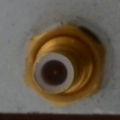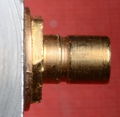SMB connector: Difference between revisions
Jump to navigation
Jump to search
No edit summary |
No edit summary |
||
| Line 5: | Line 5: | ||
of being snap-on instead of having a screw-on grounding nut. They were first used | of being snap-on instead of having a screw-on grounding nut. They were first used | ||
internally in 1960s sampling and pulse gear like the [[1S1]], [[4S1]], and [[284]], | internally in 1960s sampling and pulse gear like the [[1S1]], [[4S1]], and [[284]], | ||
later also for auxiliary signals on front panels in equipment like the [[DC505]], [[DC5010]], [[7A42]] and [[7D15]]. | later also for auxiliary signals on front panels in equipment like the [[DC505]], [[DC5010]], [[AFG5102]], [[7A42]] and [[7D15]]. | ||
In general, SMB connectors are more widely used inside of RF equipment (on module interconnects, for example) than on front panels where SMA is more frequently found. | In general, SMB connectors are more widely used inside of RF equipment (on module interconnects, for example) than on front panels where SMA is more frequently found. | ||
Latest revision as of 07:39, 22 January 2022
SMB connectors are miniature snap-on RF connectors developed in the 1960s.
They come in 50 Ω and 75 Ω variants. Their RF performance in somewhat inferior to SMA connectors, but they are more compact and have the convenience of being snap-on instead of having a screw-on grounding nut. They were first used internally in 1960s sampling and pulse gear like the 1S1, 4S1, and 284, later also for auxiliary signals on front panels in equipment like the DC505, DC5010, AFG5102, 7A42 and 7D15.
In general, SMB connectors are more widely used inside of RF equipment (on module interconnects, for example) than on front panels where SMA is more frequently found.


